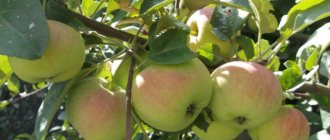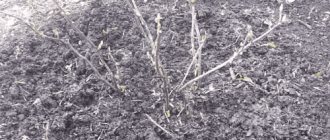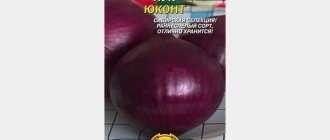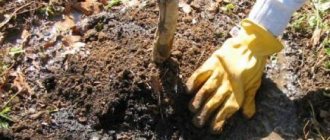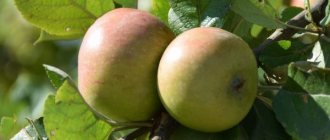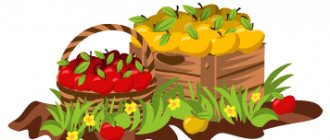The Canadian apple variety Mantet has been known since 1928; it was bred at the experimental station in Morden by open pollination. The Moscow Grushovka seedling was taken as the basis for the new variety.
The apple tree variety Mantet, resulting from pollination, has lost the winter hardiness and tallness of its progenitor, but has increased the size of the fruit and its taste.
The Mantet apple tree is included in the Rosreestr for the Central and Middle Volga regions.
Characteristic
Tree height
Average, 4–4.5 meters . This variety is not very vigorous, which is an advantage for small areas.
Crown
- Oval shape,
- Quite rare
- With strong, upward-pointing skeletal branches.
Leaves
- Large,
- Leathery, shiny,
- With serrated edges.
Bloom
Flowers:
- Soft pink with a lilac tint,
- Fragrant,
- Very large.
Fruit
- Medium size, 120-160 gr.,
- Round-oblong shape with slight ribbing at the base,
- Yellow-green in color with a bright red speckled blush.
- The taste is dessert, sweet with a slight sourness.
- The pulp is juicy, white, tender, with a pleasant aroma.
Mantet is considered the most delicious apple of the early ripening varieties..
Tasting assessment
4.4-4.6 points.
Harvest ripening time
The end of July, but with cloudy, cool summers it can shift until mid-August.
Productivity
Above average, with good care reaches 150-170 kg per tree . Without special care, the yield is reduced to 80-100 kg.
The peak of productivity begins at the age of 15, lasts up to 30-40 years and gradually decreases.
Winter hardiness
Average, no more than – 25°. The variety is not recommended for cultivation in the Northern regions .
Disease resistance
Medium, scab resistance is low. The apple tree suffers from this fungal disease when the weather is favorable for scab: during a humid, rainy summer or autumn.
Ripening of Mantet apple fruits.
Description of the variety
Mantet, like other varieties of apple trees, has features that gardeners consider from a positive or negative side. The main advantages of the Mantet variety are early ripening and high yield .
Tree
The fruit tree grows at an average speed. Young trees grow faster, but over the years the growth rate slows down. An adult tree reaches 4-5 meters in height.
What does the tree look like:
- she has a strong and straight trunk;
- few skeletal branches;
- in young apple trees, the lateral branches are directed upward;
- with age and under the weight of fruits, large branches descend to the ground;
- The shape changes over the years; in adult apple trees it becomes spreading.
Leaves
The leaf blade is leathery, smooth and shiny, not pubescent. The leaf is hard to the touch and tears easily.
What the leaves look like:
- they are large, oval in shape;
- with a wavy serrated edge;
- the tip of the leaf is pointed and directed upward;
- each leaf is planted on a thickened and long petiole;
- the leaf blade is slightly deflected away from the shoot.
Flowers
The apple tree blooms abundantly and lushly. The tree blooms in late April - early May. The flowers are saucer-shaped and large. They are completely white or slightly pinkish from the middle.
Fruit
When assessing fruits, experts take into account several parameters at once . In terms of tasting qualities, Mantet apples are rated with a maximum score of 5 points.
The fruits of the Mantet apple tree are characterized by several parameters:
- Appearance . A strong, beautiful apple that fits in the palm of your hand. It has a pleasant aroma that evokes appetite.
- Color. An unripe apple is greenish-yellow. When ripe, it turns reddish-orange with a striped blush.
Form. Round and slightly elongated.- Weight. Apples are medium and large. Weight ranges from 100 to 180 grams.
- Pulp. It is juicy, of moderate grain. Completely white or yellowish. When overripe, it turns pink and veins form in it. When fully ripe, the pulp becomes loose.
- Skin. It is thin and soft, with a neutral taste. The skin is easily separated from the pulp and does not interfere with the consumption of fresh fruits or during canning.
- Safety. Apples do not last long, 1-2 weeks. The maximum shelf life for apples without damage is 3 weeks.
- Taste. Mantet apples are characterized by a sweet, balanced taste with moderate, refreshing acidity.
- Compound. There are sugars, organic acids, pectin, many micro and macroelements, fiber and tannins, essential oils.
- Calorie content. The energy value of 100 grams of the edible part of an apple is 45 kcal.
Do you like the taste of Mantet apples?
Yes, very No, not for everyone
Frost resistance
The winter hardiness of the variety is average. Severe spring frosts are especially dangerous for apple trees. They can damage flowers and significantly reduce yields. Until 4-5 years of age, apple trees are covered for the winter.
Pollination
The Mantet variety is self-sterile. This means that pollinator varieties need to be planted near it. They may be:
- Padding,
- Melba,
- Red Melba,
- Orlinka,
- Grushovka Moskovskaya,
- White filling.
It is important that they bloom at approximately the same time.
Productivity
Single fruits appear on the apple tree at 3-4 years of age.
With each subsequent year, the harvest volume is growing steadily. Young trees, which are 7-8 years old, produce up to 50 kg of apples per season . It is possible to remove 70 kg or more from 10-year-old apple trees.
The productive age of trees is 20-25 years, which is considered quite a long time. Like many others, the Mantet apple tree bears fruit every year.
Ripening period
The Mantet variety produces a harvest in mid-summer. Apples ripen gradually from the end of July into August. In cool climates, the ripening period for apples shifts slightly and moves to September.
Harvest storage
Mantet apples are dessert apples with a gradual ripening pattern . Ripe fruits are removed from the branch and eaten. Overripe fruits fall off and quickly deteriorate. The Mantet variety is universal for eating and harvesting.
In a personal garden, due to the good yield and quick spoilage of apples, you should not plant more than 1-2 Mantet apple trees.
To keep apples longer, they need to be kept in a cool place. This could be a refrigerator or a basement. They can stay here for more than a month. Excess apples are used for processing - for jam, marmalade, marmalade, juice, freezing, and drying.
Reviews
Elena T., Chelyabinsk. “I love this variety for its early apples. They are similar to Grushovka, only tastier and more aromatic. I planted this tree about 20 years ago, after reading the description, photos, reviews. Now we are harvesting a good harvest from it, about 15 buckets .
I put some in the refrigerator, so they are stored for 3 weeks, and from the rest I make juice for the winter. A bucket of apples yields 2 liters of juice.” Irina Vladimirovna S, St. Petersburg . ‟Mantet bears fruit every year . And almost every year it is affected by scab. But here in St. Petersburg it is humid. I used to treat it for scab, and it disappeared. Then I got tired of it and haven’t sprayed anything for 4 years now. And still the harvest is normal. I like that ripening is spread over 2-3 weeks, which means that the entire harvest does not have to be harvested at once. Where to put so many of them at once? We eat apples from the end of July until mid-August.”
Egor, 32 years old, Pskov ‟I planted a Manteta seedling 5 years ago after seeing a photo and description of the variety. The first “harvest” was an apple the size of a child’s fist, we tried it 2 years after planting . Now the tree is already 3 meters in height, growing well, unpretentious. I treat for scab 2 times a season: after flowering, when the fruits have set and after harvesting. The apples are sweet, with a slight sourness, I like it.”
Apple tree Mantet - a foreign guest with Russian roots
The Mantet apple tree variety has quite a long history, and over the past time it has gained many fans not only in its homeland in Canada, but also far beyond its borders. The reason for this is the excellent taste of apples and their early ripening. In the article we will evaluate the advantages and disadvantages, and also describe in detail this interesting variety.
Landing
In order for the apple tree to grow well and delight you with the harvest, you need to plant it correctly and care for it.
During the season, the apple tree needs watering (if there is no rain for a long time), removing weeds from the tree trunk, pruning and fertilizing.
To plant a tree, you need to choose a dry place, protected from strong winds.
It is unacceptable for groundwater to stand close (closer than 2.5 meters).
Important! If there is high groundwater in the area, it is better to plant apple trees on a semi-dwarf, or better yet, a dwarf scion. Their roots do not go deep into the ground.
The apple tree grows well in fertile, breathable soils. In terms of structure, loams, chernozems and podzolic chernozems are well suited .
Growing
The variety belongs to trees that cannot tolerate low temperatures, so young trees are planted in early April, during the dormant period, so that they have time to adapt and gain strength for the winter.
The planting site must be protected from the wind, have loose soil and a low groundwater level. If it is higher than 2.5 m, artificial embankments are created. Suitable soil type is chernozem, loam. The hole is dug several months before planting.
Landing
On the day of planting, when preparing the hole, the bottom is filled with a layer of drainage mixture. The soil extracted from it is mixed with a fertile layer, organic matter and other fertilizers (80 g of superphosphate, 40 g of potassium and 30 g of potassium salt) before forming a hill from a small amount inside the pit.
The roots of the seedling are kept in water for an hour so that they are saturated with moisture, and then moistened in liquid clay.
Then the Mantet apple tree is placed on the previously formed hill. Pay attention to the fact that the grafting site is directed to the south and rises 7 cm above the ground level. Then the roots are straightened and covered with earth.
It is important to prevent the formation of voids in the space between the roots. After compaction, the soil is moistened generously with plenty of water (15-20 l) and sprinkled with compost on top. It is important to insert 3 pegs for support at the time of planting, so that, having tied the trunk, protect it from the winds and help it grow evenly.
Care
Feeding
When planting in spring, add the following to the planting hole:
- 1-2 buckets of humus or compost;
- 50-80 gr. potash fertilizers;
- 100-200 gr. superphosphate;
- 50-70 gr. nitrogen fertilizer (urea, ammonium nitrate, ammonium sulfate).
When planting in autumn, humus and nitrogen fertilizing are not applied; only potassium and phosphorus fertilizers are added.
The apple tree is always fed according to the same scheme:
- In spring - nitrogenous fertilizers,
- In autumn - potassium-phosphorus.
Trimming
Performed in early spring before buds begin to bloom or in autumn after the first frost.
When planting, the branches of the apple tree are shortened by a third of their length.
Every year, downward growing branches that are crooked and thicken the crown are removed.
You should not remove more than a quarter of the branches in one pruning
Watering
In summer, apple trees need to be watered abundantly.
Young trees especially need watering - in the first year after planting, they are watered once every 2 weeks if the weather is dry. For one watering, 2-3 buckets of water are consumed.
An adult tree is watered 4-5 times per season, using 7-10 buckets of water.
Attention! A common mistake gardeners make is frequent but scanty watering. With it, only the top 10-15 cm of the soil are moistened and the roots of the tree lose the incentive to grow deeper in search of moisture.
Features of fruiting and ripening
Like most apple trees, the Mantet variety is self-sterile, i.e. to pollinate flowers, it needs another type of tree growing at a distance of up to 200 meters.
The best pollinators for the Mantet apple tree are considered varieties:
- White filling;
- Moscow Grushovka;
- Melba;
- Orlinka;
- Strefling.
These apple trees bloom at the same time as Mantet - in mid-May.
The variety begins to bear fruit early:
- The first fruits appear 2-3 years after planting.
- The tree quickly increases its yield,
- Keeps it for 10-15 years.
- Gradually, the yield decreases, periodicity appears - after a fertile year, the apple tree “rests” the next year.
The more fruits there are on a tree, the smaller they will grow..
The Mantet variety is famous for its early fruiting: apples ripen earlier than most others - at the end of July in the southern regions and closer to the beginning of August in the central regions. The harvest ripens unevenly, the harvest time is extended by 2-3 weeks.
Advice! The collected fruits are stored for no more than 2-3 weeks. Due to their thin and delicate skin, they are easily damaged during transportation.
History of selection
The Mantet variety was bred in Canada in 1928 by natural pollination of Mackintosh and Grushovka Moscow apple trees . Its author was Dr. A. Macoen, botanist and scientist. This variety entered the territory of the USSR only in 1971. But it became permissible for free cultivation only 15 years later - in 1986. Now Mantet apple trees are in demand and widespread.
Mantet is a popular and long-known variety, bred in Canada on the basis of the Russian Grushovka Moskovskaya.
2 apple trees took part in the selection:
- McIntosh is an old Canadian variety that has passed on its best qualities to the bred variety. This is a small height and compact crown, good yield, survival, cold resistance, taste and aroma of fruits, disease resistance.
- Moscow pear is also a long-known and one of the most successful Russian apple varieties, which has transferred some of its properties to the Mantet variety. Among them are early ripening, fruit size and shape, and good yield.
Photo of Manet apple tree:
Varieties
The variety is successfully grown on vigorous, semi-dwarf and dwarf clonal rootstocks. Which one is better to choose and what is their difference:
- On a dwarf rootstock, the tree will grow up to 2-3 meters in height, begin bearing fruit 2-3 years after planting and live 25-30 years.
- On a semi-dwarf rootstock, the apple tree will grow 3-4 meters in height, begin to bear fruit 2-3 years after planting and live 30-40 years
- On a vigorous rootstock, the tree will grow 5-6 meters in height, produce the first harvest 4-5 years after planting and live up to 60 years.
From a commercial point of view, it is more profitable to grow dwarf types of apple trees: they begin to bear fruit faster and are easier to care for.
In addition, instead of one vigorous apple tree, you can plant as many as four different dwarf varieties to diversify the taste and ripening time of the crop.
Important! Due to the close location of the root system, low-growing varieties require more frequent watering and mandatory tying to a stake in the first 3-4 years of life.
If you want a very tall apple tree, like in the gardens of our grandmothers, choose an apple tree on a seed rootstock.
Its advantages:
- It grows over 7 meters in height,
- Unpretentious and resistant to adverse environmental factors,
- Fruits for 40-50 years.
The disadvantages of such apple trees include:
- Late entry into fruiting - 7-10 years after planting.
- Inconvenient care: pruning, harvesting, pest control.
- The quality of apples is lower than that of low-growing and medium-growing varieties.
Columnar apple trees are less winter-hardy ; the upper part of their trunk often freezes.
The tree begins to bush and the yield decreases. They should be given preference in warm regions with non-cold winters or covered for the winter with a white covering material: lutrasil or spandbond.
Columnar apple trees.
The advantages of the columnar type are that it begins to bear fruit in the second year after planting and the compactness of the crown.
Harvesting
The first apple can be picked already at the beginning of the third decade of July. The harvest will last until the beginning of September, and the apples need to be collected in several batches, not allowing them to overripe. It is better not to let the apple ripen a little than to remove it from the tree with loose pulp.
The harvest is harvested in several passes, which allows you to consume fresh apples for two months
Collected apples are stored for about a month, so it is advisable to consume them fresh as soon as possible or send them for juice. They make excellent preserves and jams. Baked Mantet apples and a variety of homemade baked goods made with them are also very tasty.
The Mantet apple tree has become widespread due to its early fruiting and excellent taste of the fruit. It is not resistant to scab and requires immediate processing of the harvested crop. However, if you take timely measures to protect the tree from diseases and pests and know in advance what needs to use the collected apples for, then you will not have problems growing and maintaining this variety in your garden plot.
Source of the article: https://maja-dacha.ru/yablonya-mantet-zarubezhnyiy-gost-s-russkimi/
Is it suitable for the Moscow region?
The Mantet apple tree is included in the register of varieties suitable for cultivation in the Central region of Russia , which includes the Moscow region.
The Mantet apple tree is not highly winter-hardy and can freeze in particularly harsh winters .
How to minimize the risk of freezing:
- Select a seedling grown at a local nursery .
- For planting, choose a sunny place, avoiding lowlands and heavily windy areas.
- For the first three years, cover the seedling without winter.
Useful tips
- To find out at what depth to plant a seedling, look at the grafting site: it should be 5-7 cm above the soil level.
- In the year the apple tree first blooms, it is better to leave 1-3 flowers on it and pick off the rest. The strength of a young tree is not enough to grow shoots and bear fruit at the same time.
- If the soil on the site is heavy and oily, dig a large planting hole: 70-80 cm deep and 60-80 cm wide. You need to add 3-4 buckets of sand to the soil removed from the hole, and fill the hole with the prepared mixture when planting. The sand will loosen the soil, making it easier for the seedling to grow.



